This delicious buckwheat sourdough loaf is completely gluten-free and vegan. The bread is soft, and flexible, and stays moist for days after baking! For another variation of GF sourdough check out my other easy gluten-free sourdough bread recipe!
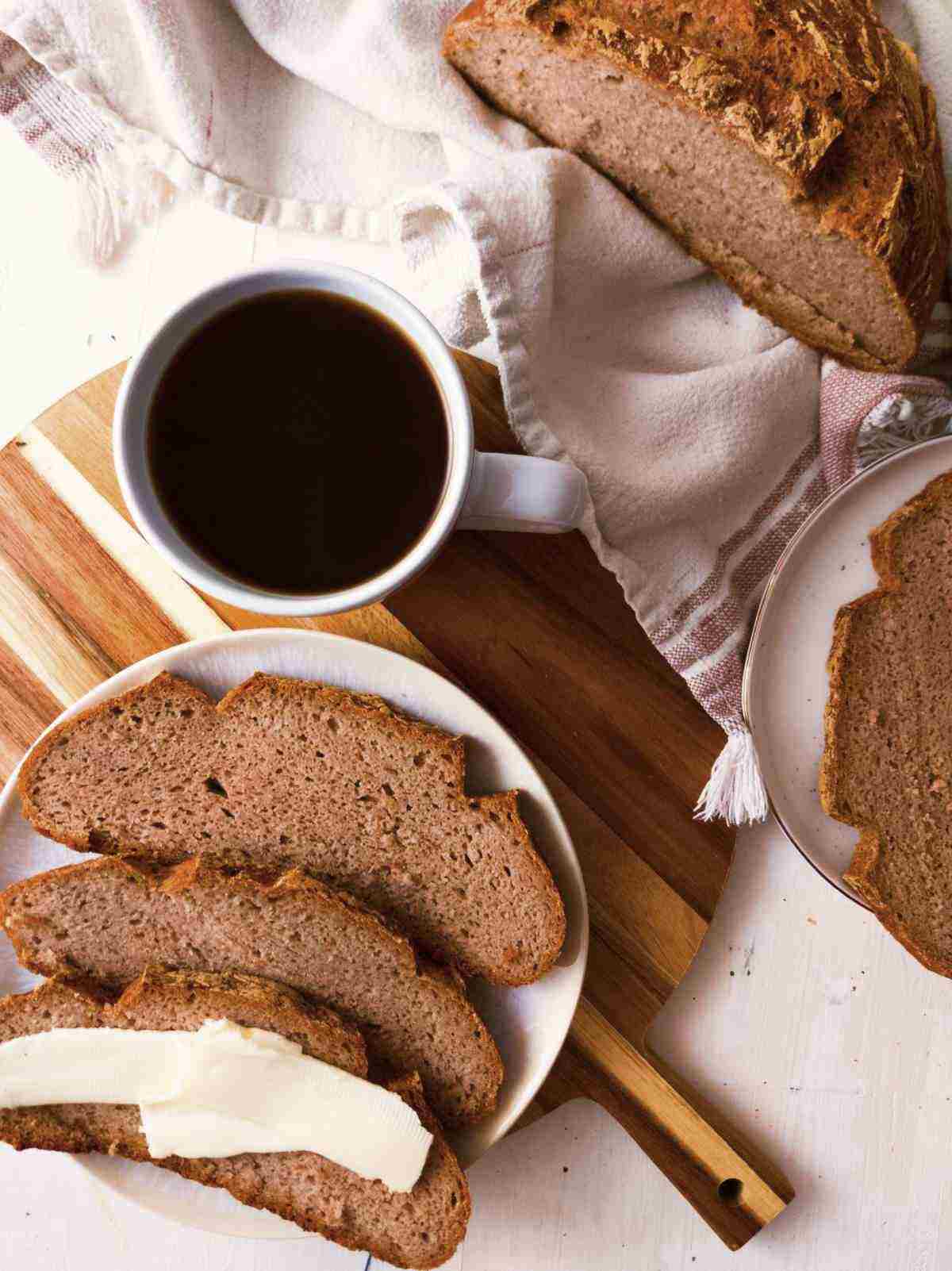
Jump to:
- Why You Will Love This Recipe
- Is Buckwheat Gluten-Free?
- What is a mature sourdough starter?
- What is levain?
- Why Psyllium Husk?
- What Flour is Best For GF Sourdough?
- Sourdough Terminology Explained
- Tools You Might Need
- Ingredients
- Substitutions
- Variations
- Step-By-Step Instructions
- Baking Timeline
- Expert Tips
- FAQ
- 📖 Recipe
- 💬 Community
Why You Will Love This Recipe
- No-fail recipe. If you follow the instructions, you will get consistently great results.
- Vegan and gluten-free. Buckwheat is naturally gluten-free in spite of its misleading name and the rest of the ingredients are free of wheat as well!
- Very flexible schedule. You can adjust the timeline to your needs.
Is Buckwheat Gluten-Free?
Yes, buckwheat is naturally gluten-free in spite of its name. Buckwheat flour is made by grinding whole grain buckwheat groats which with the appropriate equipment, you might even be able to make at home!
In gluten-free baking, buckwheat flour allows for that whole wheat flour effect without actually using any wheat. You can also make buckwheat desserts, 100% buckwheat yeasted bread, and buckwheat wraps.
What is a mature sourdough starter?
Sourdough starter is wild yeast that is used to make naturally leavened bread, aka sourdough bread. A mature sourdough starter is a starter at its peak activity, meaning you fed the starter with fresh water and flour and it has risen to its full capacity.
At that point, bacteria have multiplied and gained strength, so it will do better at raising your loaf during bulk fermentation. You can make plenty of gluten-free sourdough recipes with it!
New to gluten-free sourdough? Watch my 16-minute video tutorial for beginners!
What is levain?
Levain is traditionally used for sourdough bread to strengthen a mature starter before using it in the recipe. To make levain you need to take a mature starter, feed it with water and flour, and let the mixture rise to its full capacity again.
In gluten-free bread baking the only person I came across who implemented the idea of levain for gluten-free sourdough bread is Rachel Conners on her Bakerita food blog and I really liked the idea as gluten-free bread needs all the help it can get to rise well!
Why Psyllium Husk?
There are a few binders for gluten-free bread, some of them being xanthan gum, guar gum, and psyllium husk. I used to bake with xanthan gum but once I tried psyllium husk I never went back.
Psyllium husk is a very strong binder that does its job so well that you can literally knead the gluten-free dough (which is never the case with xanthan gum!).
So, for this recipe, you can’t use xanthan gum. If you really like bread, you will thank yourself later for using psyllium husk in this recipe!
What Flour is Best For GF Sourdough?
I recommend mixing your own flours vs. using a premade bread flour mix. As sourdough is not as predictable as sandwich bread made with commercial yeast, you want to make sure you control as much as possible in the recipe.
That includes the ingredients! Premade blends might use too much starch which will prevent the loaf from rising. However, if you insist on using a blend, you can try and see whether it works for you!
If you can't have starches, check out my sourdough recipe made with brown rice flour and this whole grain millet sourdough.
Sourdough Terminology Explained
Levain – a second maturing of a sourdough starter.
Bulk Fermentation (Bulk rise) – the rise of the dough.
Proofing – in sourdough baking there are two stages of bread rising, the bulk rise and proofing. However, in gluten-free sourdough baking bulk rise and proofing are happening at the same time.
Banneton baskets – baskets that are specifically designed for proofing sourdough bread. Using them has its benefits but it is not necessary for bread baking. I normally use a mixing bowl lined with a kitchen towel instead of bannetons (although I do want to get bannetons for bread baking soon!).
Scoring – cutting lines on the loaf before baking it. By cutting into the loaf you determine the ways for steam to escape through thus creating a nice pattern on the bread. If you don’t score the bread, then steam will break the crust in random spots making the bread look less attractive!
Tools You Might Need
- Dutch oven, (there are plenty of other gluten-free Dutch oven recipes!)
- kitchen towels;
- a whisk;
- a rubber spatula;
- a few mixing bowls;
- a banneton basket (optional);
- a sharp knife or a razor.
Ingredients
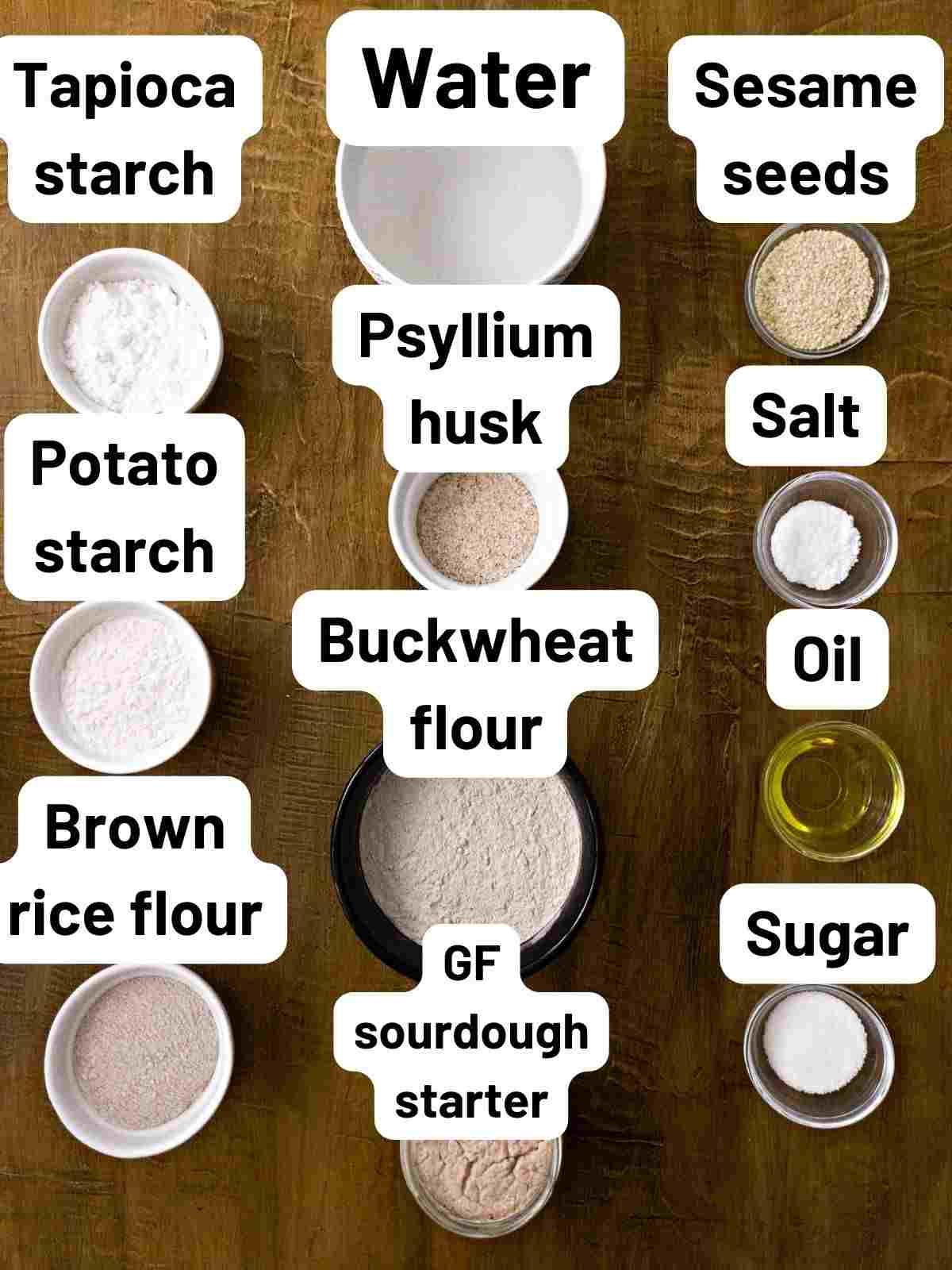
Psyllium husk - make sure you use whole husks and NOT psyllium husk powder! Check my psyllium husk guide for more instructions.
Flour - for all types of flour use very finely ground flour.
Substitutions
Sugar – use honey or maple syrup in place of sugar or check out my extensive list of great sugar substitutes.
Potato starch – use cornstarch as a substitute 1:1.
Tapioca starch (flour) – use arrowroot starch (flour) 1:1 as a substitute.
Sea salt – you can use Himalayan or regular salt instead.
Sesame seeds - poppy seeds work great, but if you don't have that either, check out my extensive list of sesame seeds substitutes!
Brown rice flour – use white rice, oat, and sorghum flour in place of brown rice flour.
Variations
The round-shaped bread you see in the pictures is called boule bread. However, you can make a brick-style sandwich bread by baking the bread in a bread pan. In that case, let the bread proof and rise in the bread pan to avoid reshaping and transferring.
You can also make baguette bread by baking it in a baguette pan!
Step-By-Step Instructions
Step 1 – Prepare the levain
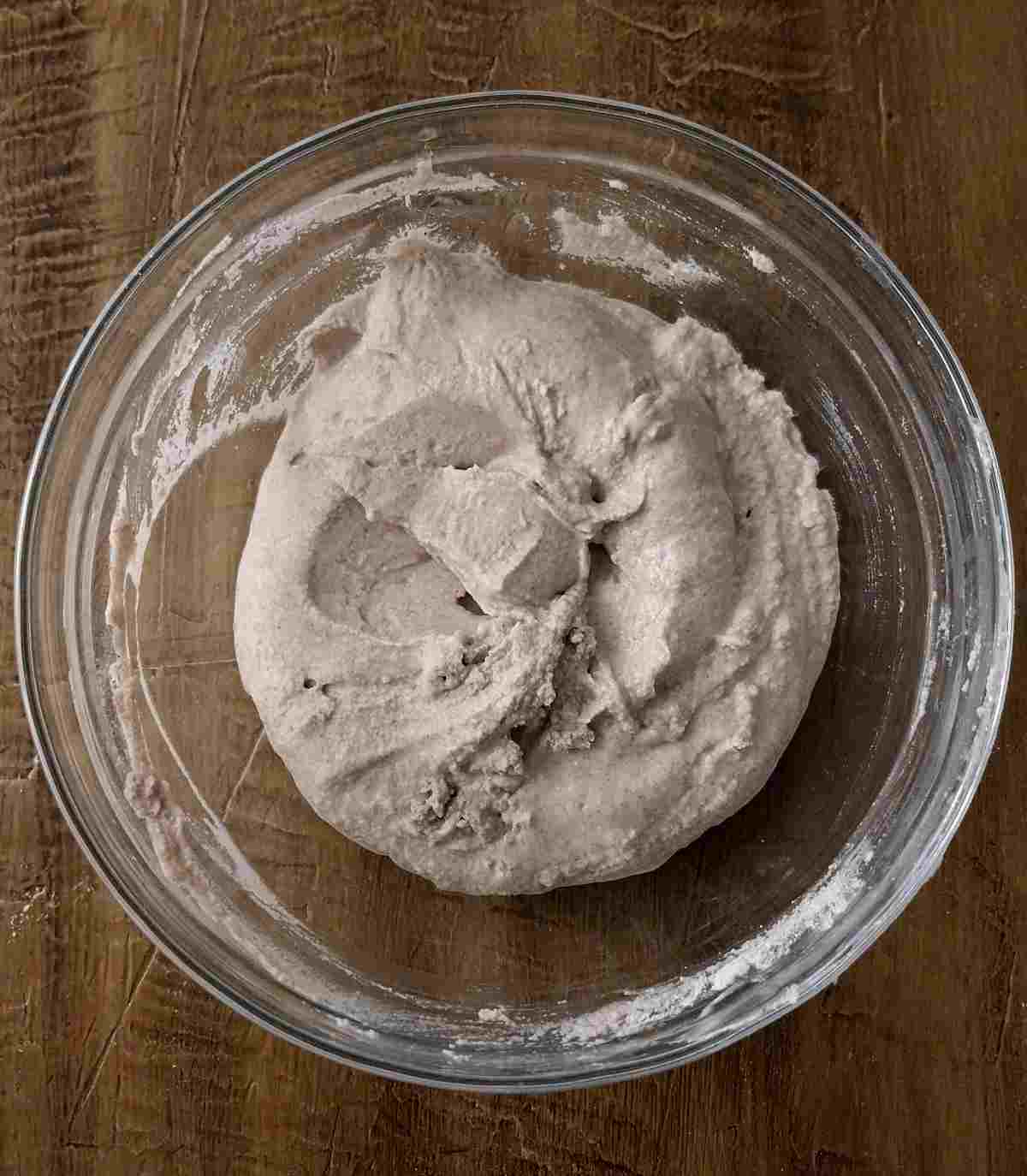
First, to make levain, you need to add 150g of mature GF sourdough starter, 80g of buckwheat flour, and 100g of water (not hot) to a mixing bowl. Mix until all ingredients are well incorporated, cover with a kitchen towel, and leave to rise for 5-6 hours.
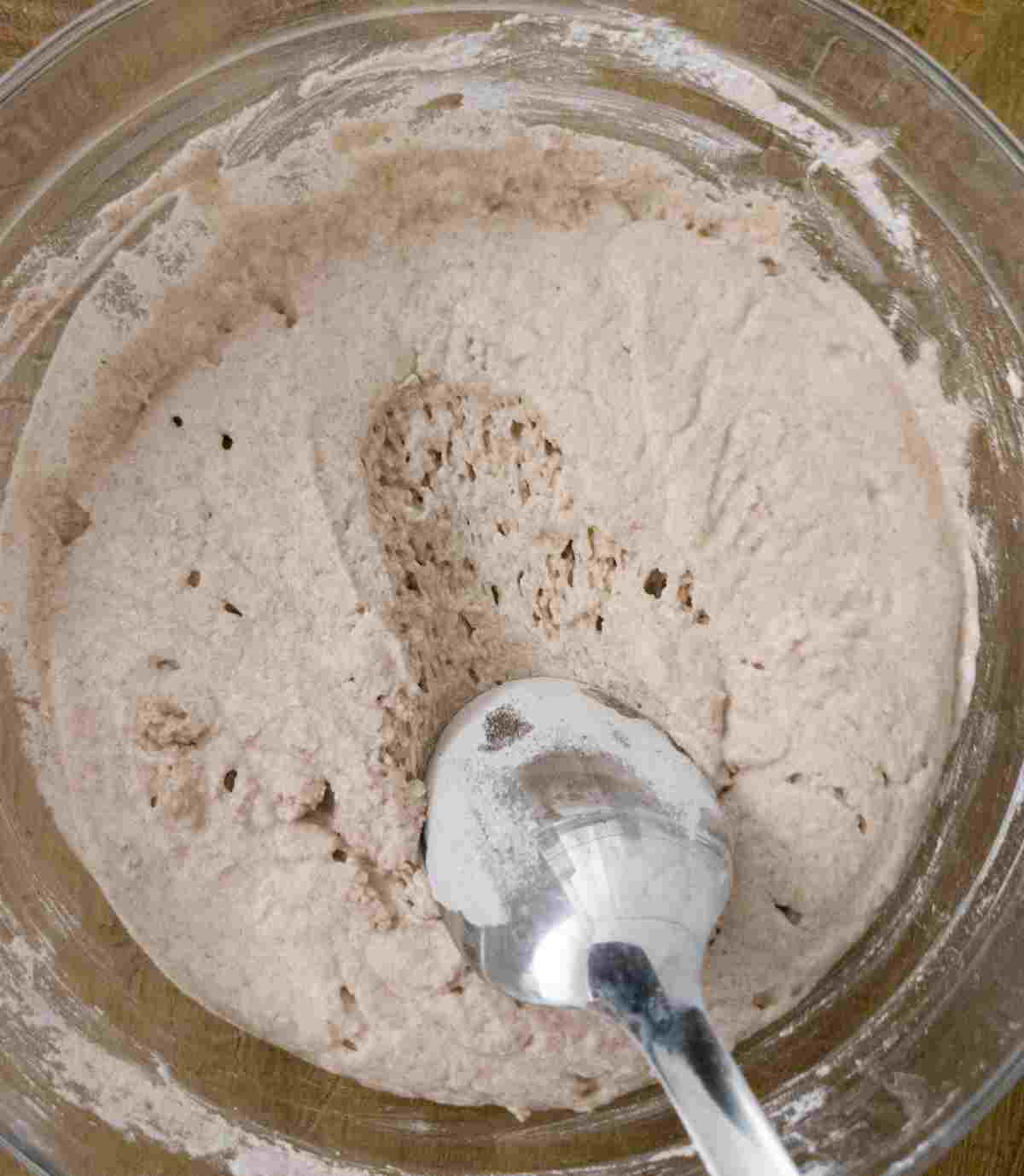
You know levain is ready when it has risen some (it will not double in size) and when you scoop a bit with a spoon, you hear and see the bubbles created by the wild yeast.
* The length of time for this stage will depend on the temperature in your kitchen. To speed up the process place the levain into a turned-off oven with the light on.
Step 2 – Bring the dough together
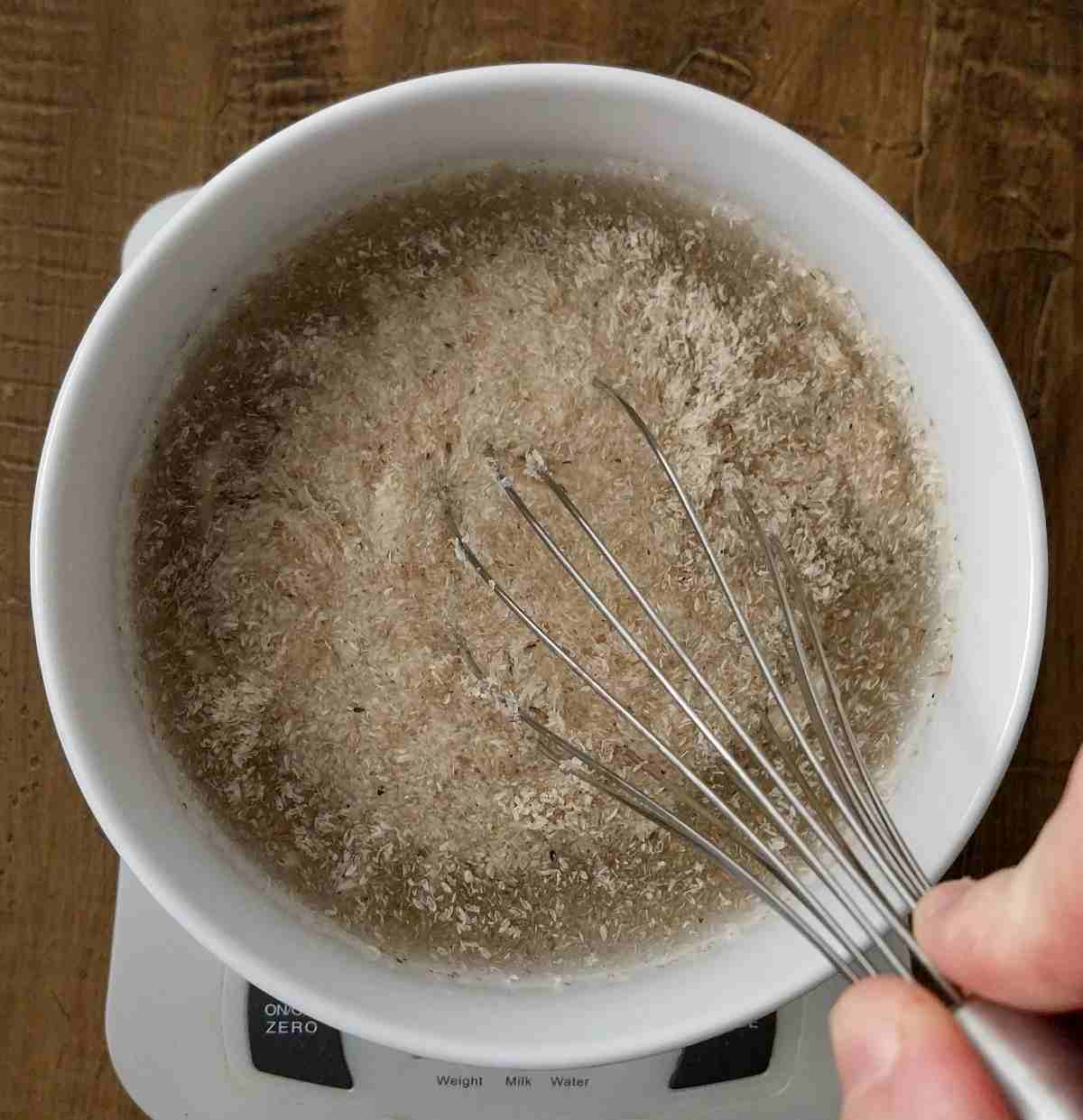
Once levain is ready, in a separate bowl, add 20g of psyllium husk, 10g of oil, 20g of honey, and 300g of water (not hot). Whisk to combine and set aside.
In another bowl add the remaining buckwheat flour, brown rice flour, potato and tapioca starches, and salt. Whisk to combine and set aside.
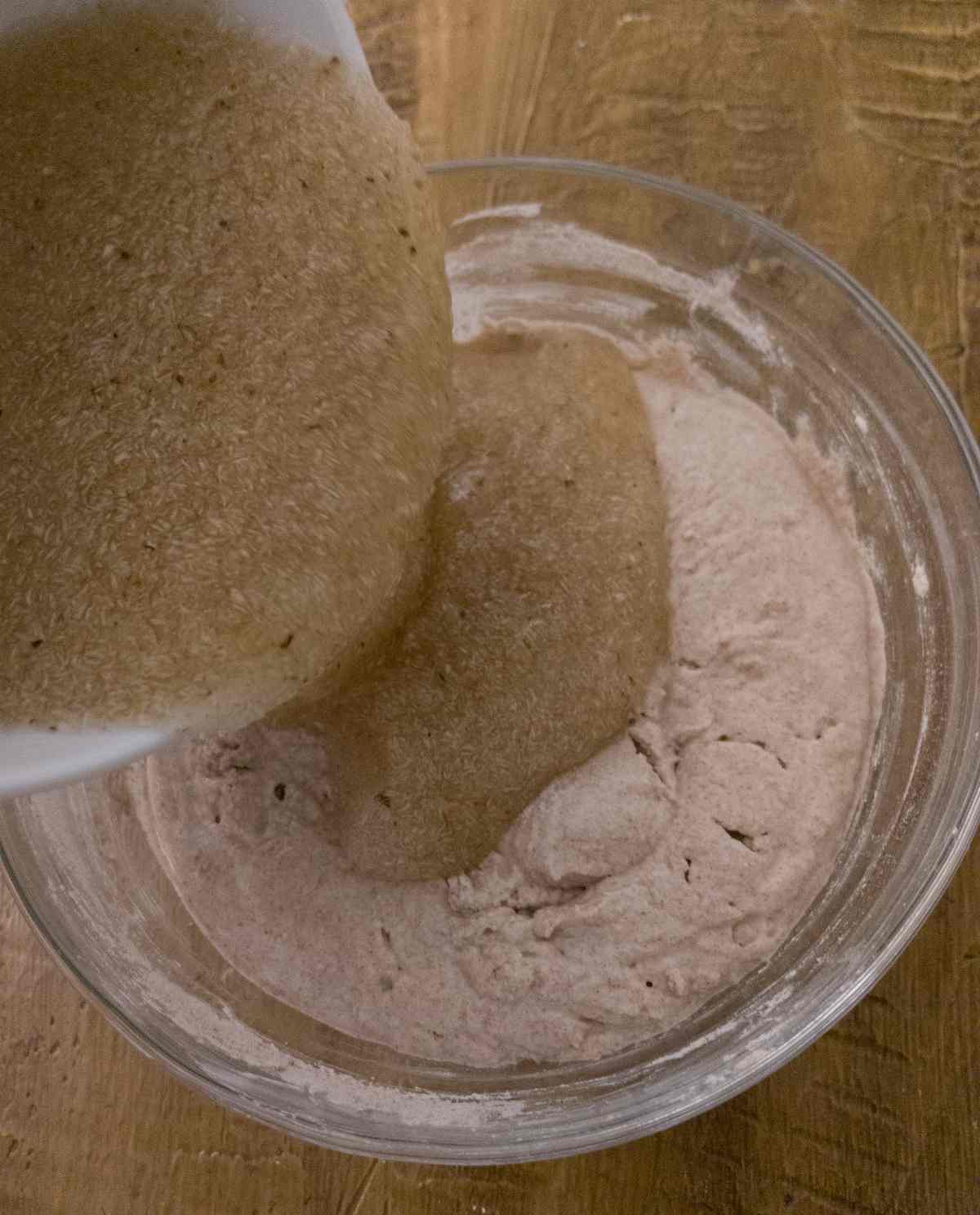
By now psyllium husk has gained a gel-like consistency. Add the psyllium husk mixture to the levain and mix with a whisk until well combined.
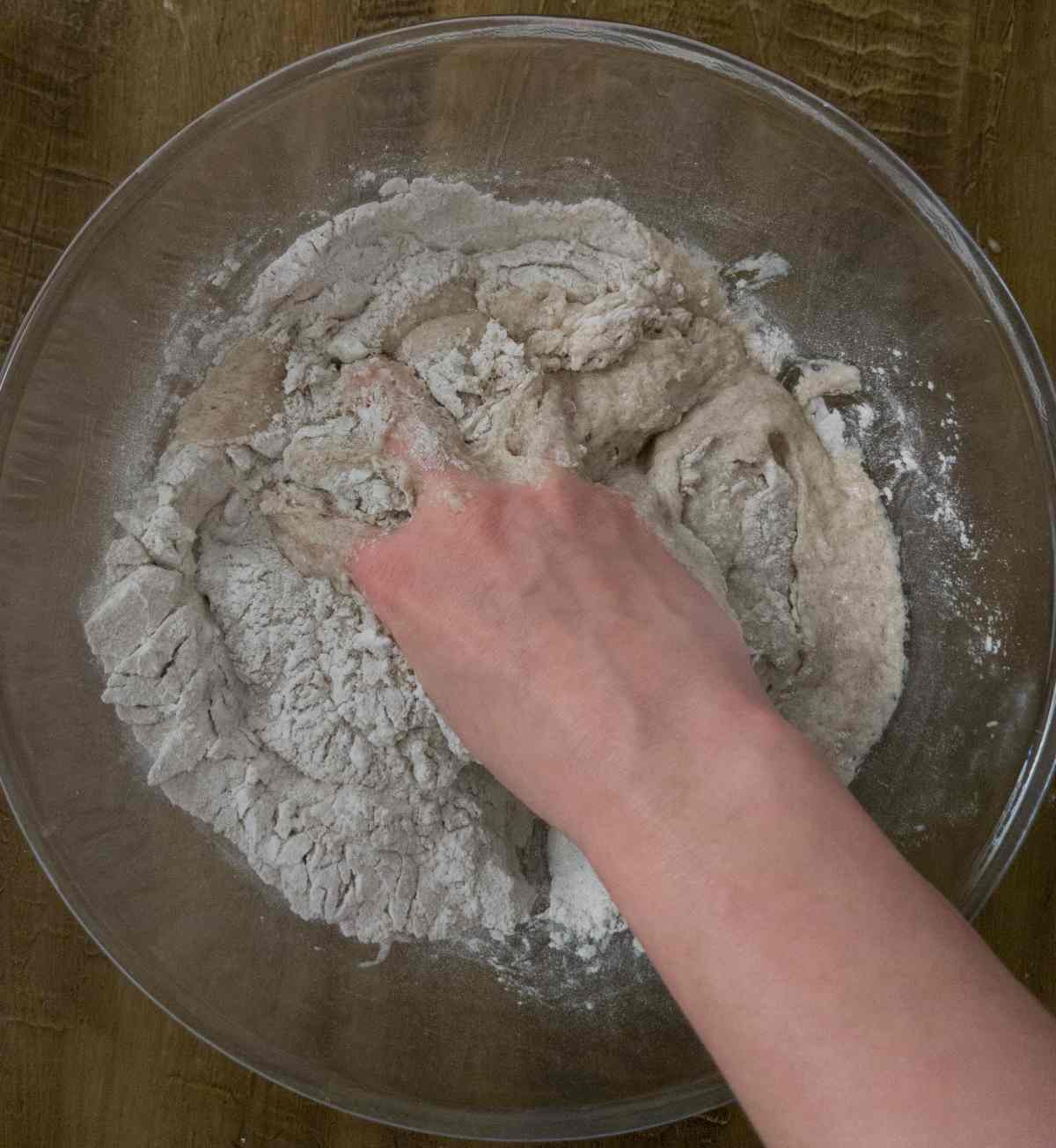
Then, add the dry ingredients to the wet ingredients. With your hands, mix the dough until all flour is incorporated and transfer the dough onto the kitchen table.
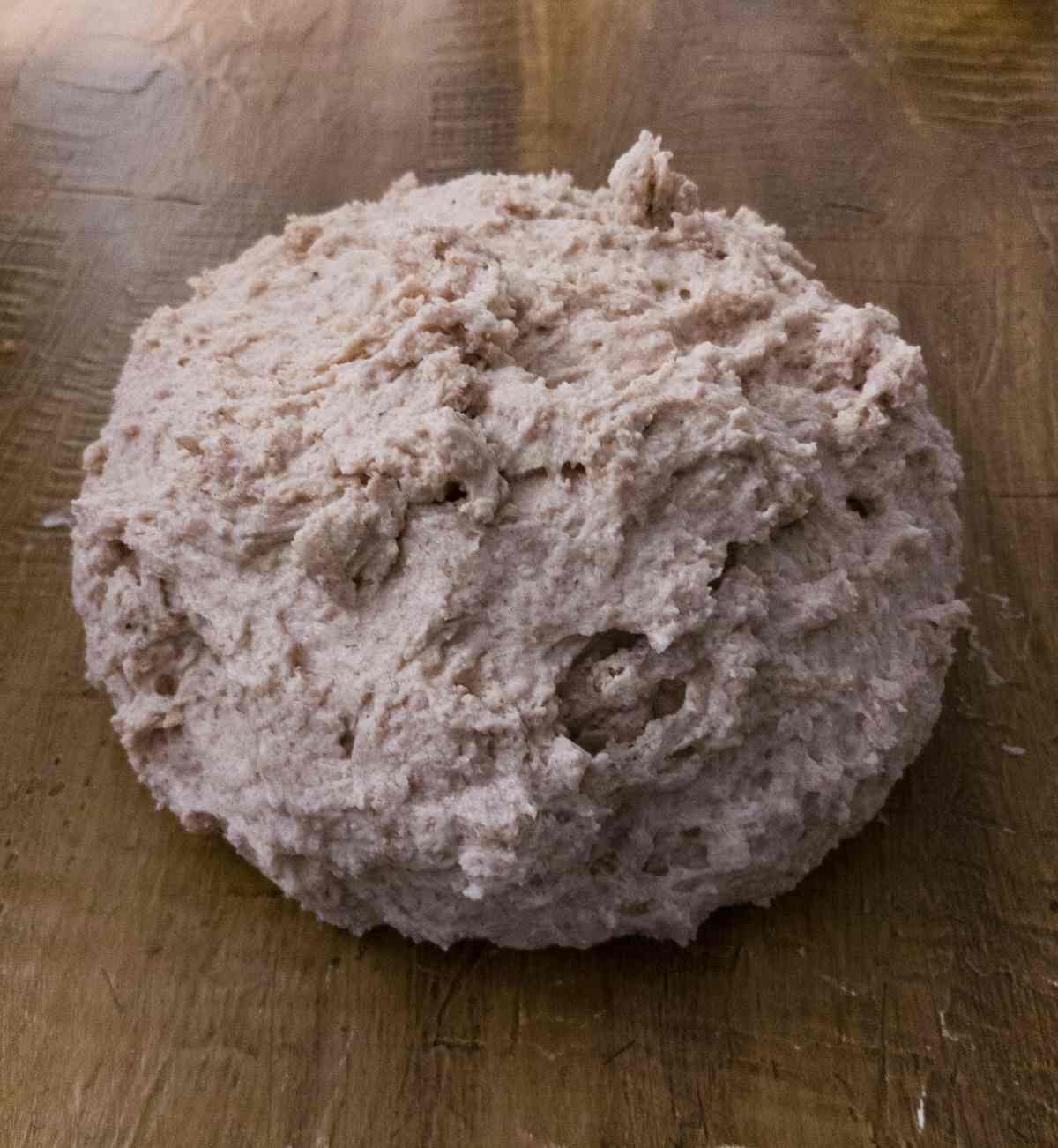
Shape the dough into a ball.
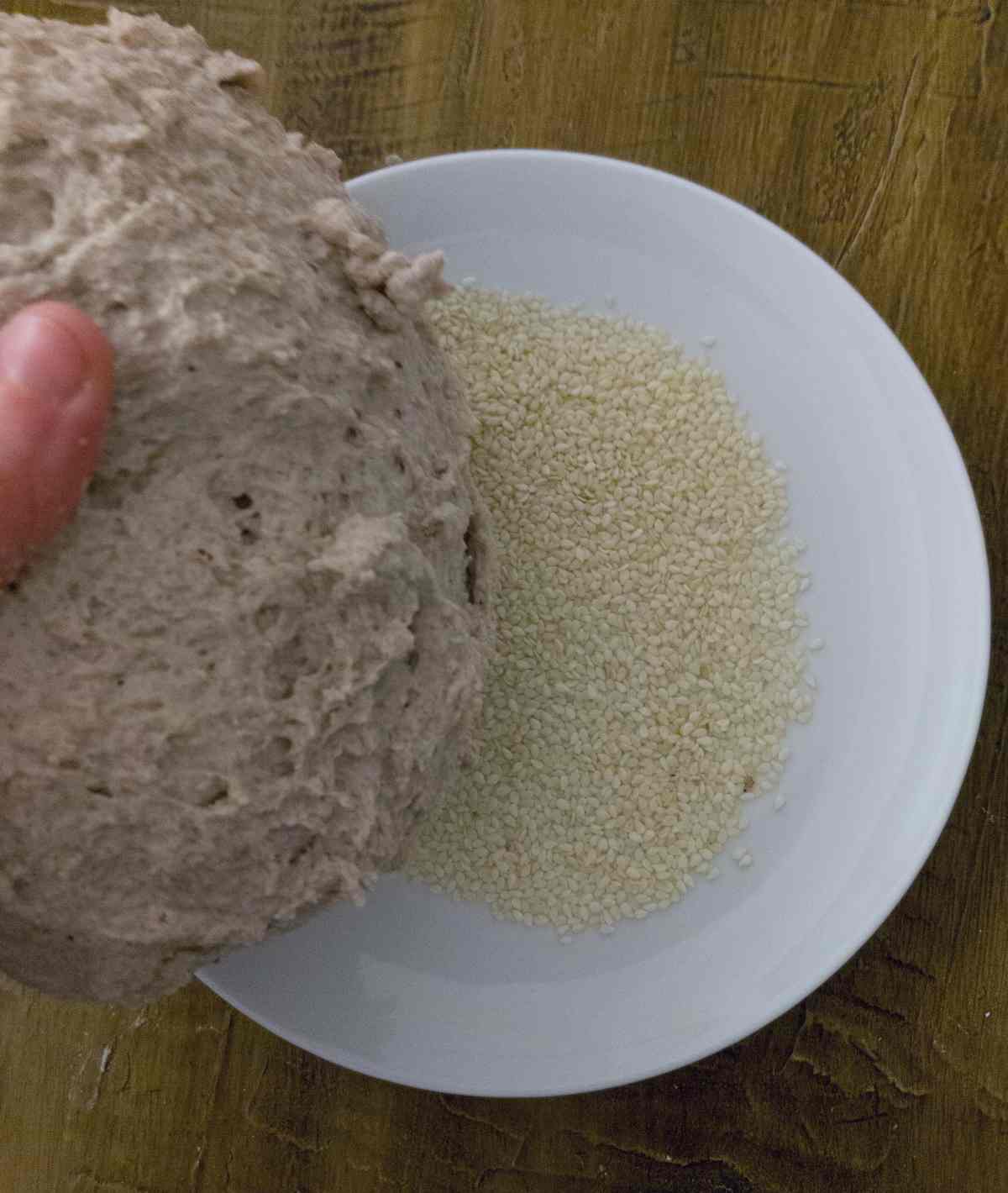
Then, pour some sesame seeds onto a small flat plate and dip the top of the dough into them.
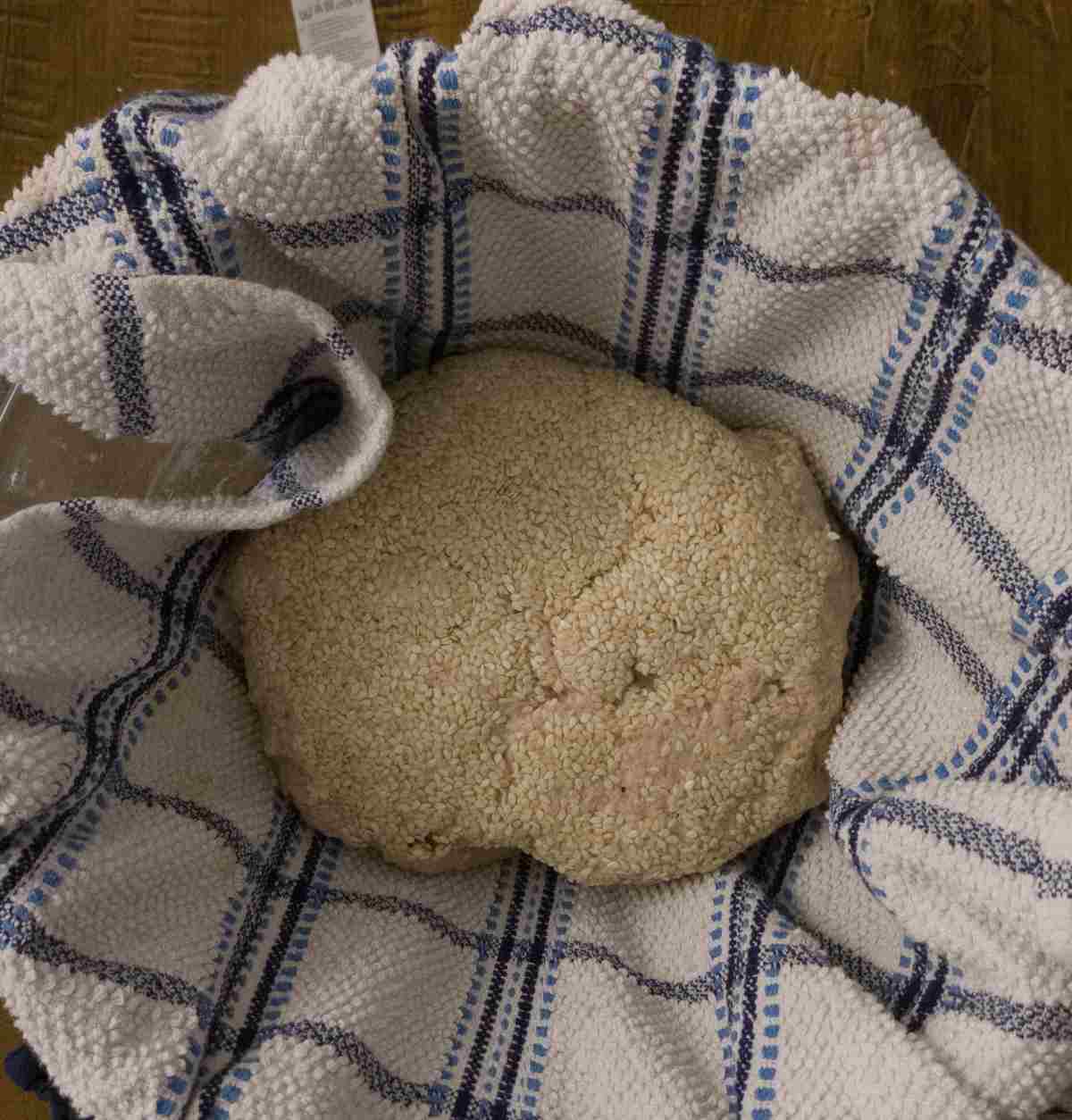
Then, place the dough into a banneton basket or a mixing bowl lined with a tea towel. Cover with another kitchen towel and leave for the bulk fermentation. This stage will take 5-6 hours at room temperature or 12-18 hours in a refrigerator.
Step 3 – Bake
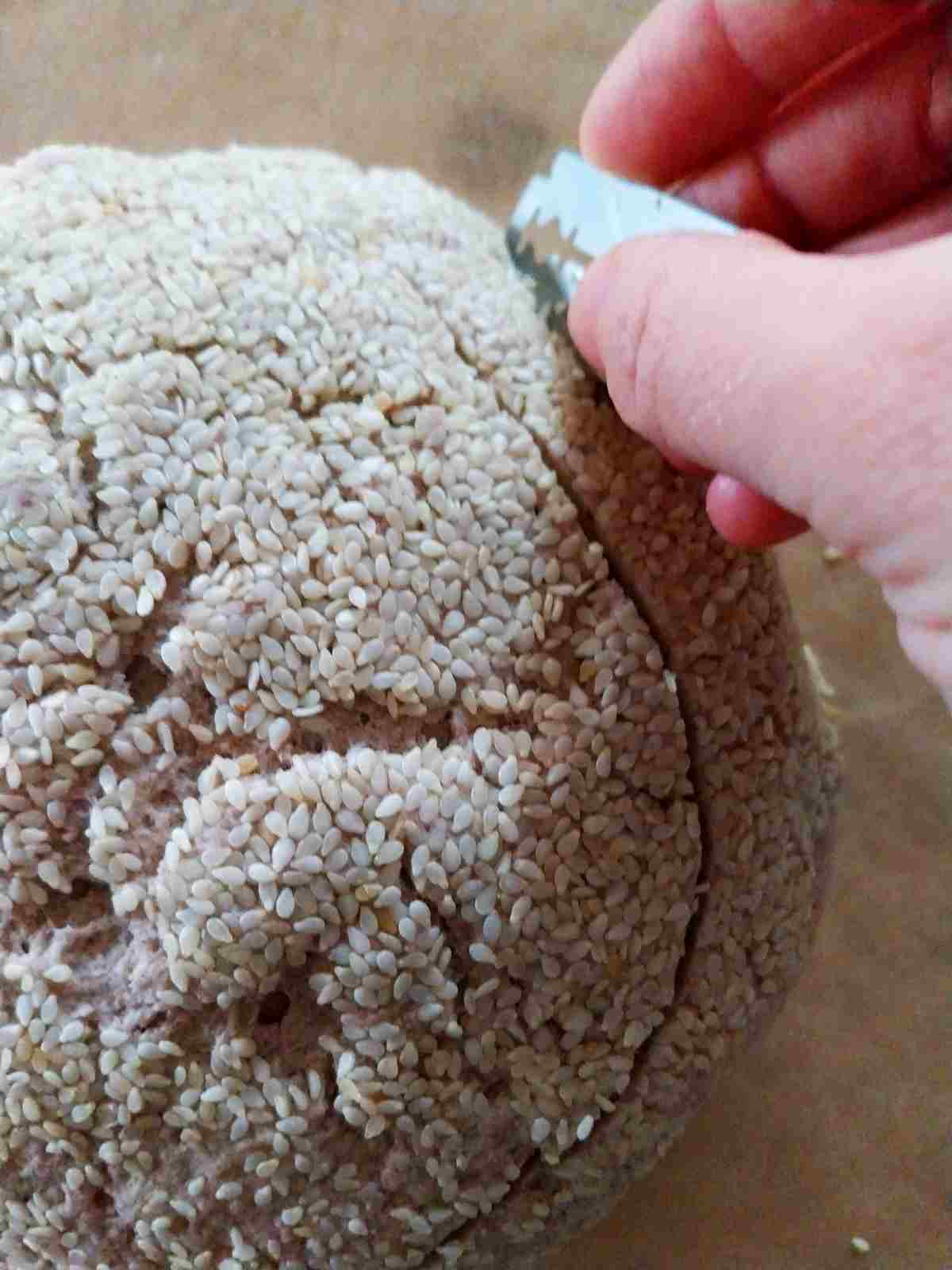
When the bulk fermentation is done, your bread will have risen some but it will not have doubled in size. Preheat the oven with the Dutch oven inside to 430F/220C. Once the oven is hot enough, place the dough onto a piece of parchment paper and score the loaf.
Then, transfer the dough with the parchment paper into the Dutch oven and place the lid on. Bake for 45 minutes, then, take the lid off, turn the heat down to 375F/175C and bake for another 20-30 minutes.
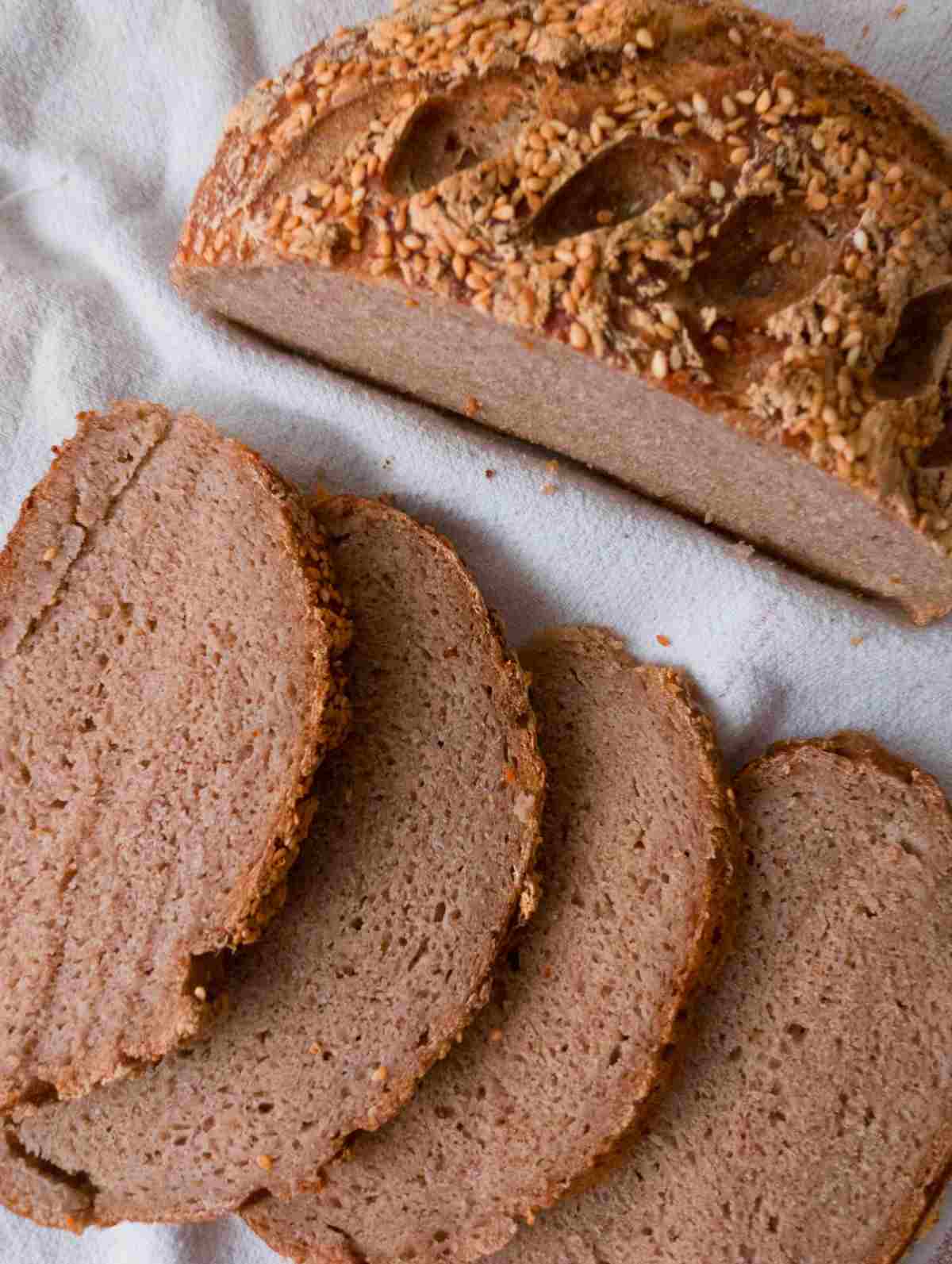
Once the bread is baked, transfer it onto a cooling rack and let the bread cool completely before cutting into it. If you cut the loaf too soon it will have a gummy texture as the bread is still baking after you took it out of the oven.
Baking Timeline
Overnight:
9 am – feed the starter.
2 pm – make the levain.
7 pm – add the rest of the ingredients and shape the dough.
7 pm-9 am – overnight proofing in the refrigerator.
9-10 am – baking time!
Same Day:
6 am – feed the starter.
11 am – make the levain.
4 pm – add the rest of the ingredients and shape the dough.
4-9 pm – bulk rise at room temperature.
9-10 pm – baking time!
Expert Tips
- Don’t substitute psyllium husk for any other type of gluten-free binder.
- Go by the state of the dough rather than by the recipe timeline. If your starter or loaf seems like they are not ready after 6 hours, give it more time. If they are ready sooner, use them when you need to! Sourdough is not as predictable as bread made with commercial yeast!
- To score your bread, use a very sharp knife or a razor to avoid pushing the dough down and popping the bubbles inside the dough.
- If you accidentally waited too long and your starter started to go down or your bread became overproofed, don’t stress over it, bake the bread anyways. It will be delicious still!
FAQ
Cutting into the bread too soon, not baking for long enough, and adding too much liquid to the starter (or the dough), all can be the reason for a gummy crumb. Buckwheat absorbs less liquid than oat or brown rice flour would, so if you are following another recipe and using Buckwheat flour as a substitute, you might get gummy results.
Sometimes it will take longer for the bread to rise. If you don’t see much activity, leave the bread for a few more hours and see what happens. If the bread doesn’t rise at all, the chances are your starter wasn’t strong enough. Try feeding your starter twice a day for a few days until you see a consistent rise (about 150%) then use it for bread.
Sometimes you will notice liquid on top of your levain after it has been sitting for some time. That could mean too much liquid in the mixture or that the bacteria already processed all of the flour and is hungry now. You can proceed with the recipe the same and see whether your loaf will be gummy. In that case, you know that you had too much liquid in the dough.
You can freeze the bread after it has been proofed. If you freeze it before that, the bacteria will fall asleep and won’t work as well after thawing!
If the bottom of your bread is black, lower the temperature slightly the next time you bake. All ovens are different, which is why it helps a lot to use an oven thermometer!
Get my Gluten-Free Sourdough E-Book today!
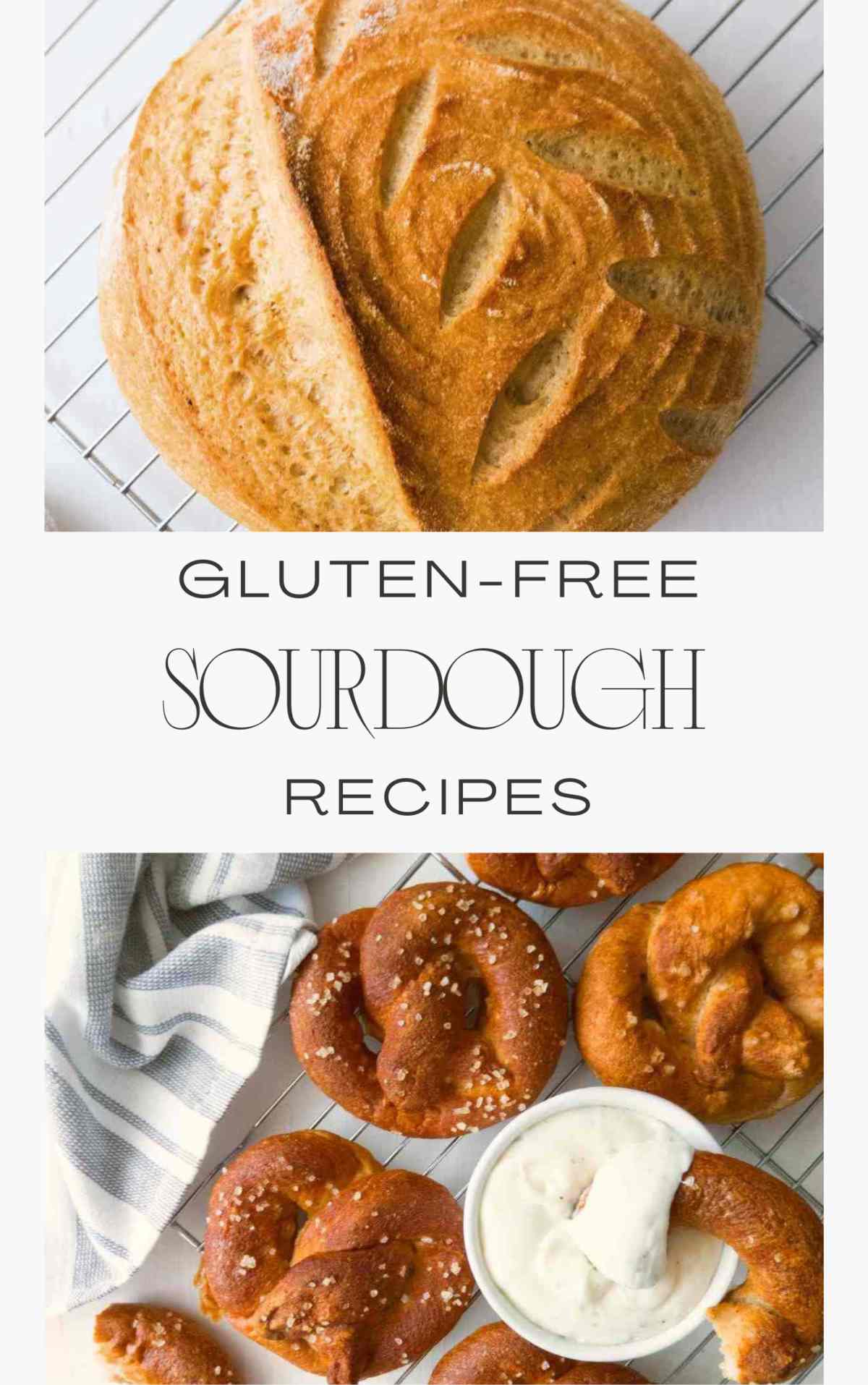
📖 Recipe
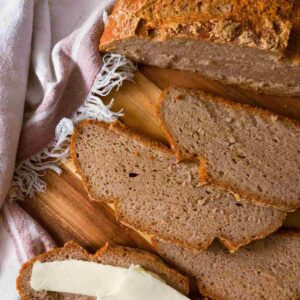
Gluten-free buckwheat sourdough bread
Equipment
- 1 whisk
- kitchen towels
- banneton basket optional
Ingredients
Levain
- 150 g mature sourdough starter gluten-free
- 80 g buckwheat flour
- 100 g water not hot
Dough
- 20 g psyllium husk whole husks, 18g if using powder, check psyllium husk guide for more information
- 10 g oil olive, sunflower, or vegetable oil
- 20 g sugar honey or maple syrup will work, too
- 300 g water not hot
- 80 g buckwheat flour
- 120 g brown rice flour add 10g more if bread turns out gummy
- 80 g potato starch cornstarch is ok, too
- 60 g tapioca starch or arrowroot
- 12 g sea salt
Topping
- sesame seeds
Instructions
- First, to make levain, you need to add 150g of mature GF sourdough starter, 80g of buckwheat flour, and 100g of water (not hot) to a mixing bowl. Mix until all ingredients are well incorporated, cover with a kitchen towel, and leave to rise for 5-6 hours.
- You know levain is ready when it has risen some (it will not double in size) and when you scoop a bit with a spoon, you hear and see the bubbles created by the wild yeast.* The length of time for this stage will depend on the temperature in your kitchen. To speed up the process place the levain into a turned-off oven with the light on.
- Once levain is ready, in a separate bowl, add 20g of psyllium husk, 10g of oil, 20g of honey, and 300g of water (not hot). Whisk to combine and set aside.In another bowl add the remaining buckwheat flour, brown rice flour, potato and tapioca starches, and salt. Whisk to combine and set aside.
- By now psyllium husk has gained a gel-like consistency. Add the psyllium husk mixture to the levain and mix with a whisk until well combined.
- Then, add the dry ingredients to the wet ingredients. With your hands, mix the dough until all flour is incorporated and transfer the dough onto the kitchen table.
- Shape the dough into a ball.
- Then, pour some sesame seeds onto a small flat plate and dip the top of the dough into them.
- Then, place the dough into a banneton basket or a mixing bowl lined with a kitchen towel. Cover with another kitchen towel and leave for the bulk fermentation. This stage will take 5-6 hours at room temperature or 12-18 hours in a refrigerator.
- When the bulk fermentation is done, your bread will have risen some but it will not have doubled in size. Preheat the oven with the Dutch oven inside to 430F/220C. Once the oven is hot enough, place the dough onto a piece of parchment paper and score the loaf. Then, transfer the dough with the parchment paper into the Dutch oven and place the lid on. Bake for 45 minutes, then, take the lid off, turn the heat down to 375F/175C and bake for another 20-30 minutes.
- Once the bread is baked, transfer it onto a cooling rack and let the bread cool completely before cutting into it. If you cut the loaf too soon it will have a gummy texture as the bread is still baking after you took it out of the oven.

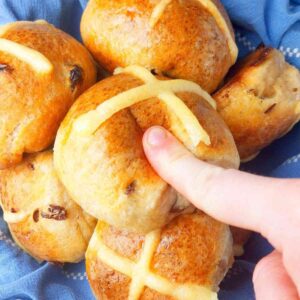
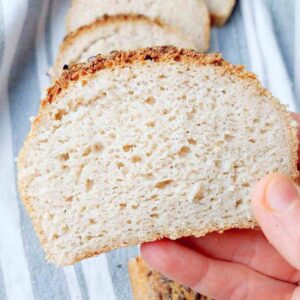
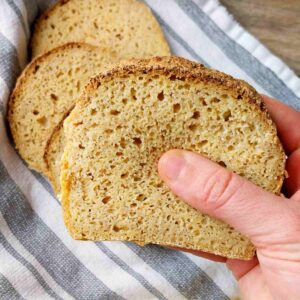
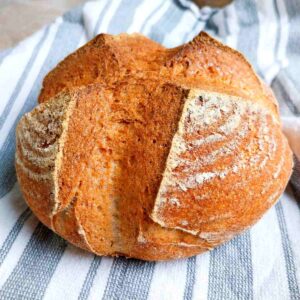
Nina Di Natale
Hi Natasha,
I just wanted to let you know that I made this bread this morning and it is perfect. Looks and smells amazing and the taste is so good.
It was very easy to follow your recipe and I used your recipe for the started as well. My hubby was own away on how good it tasted.
Natashashome
Oh, Nina, thank you so much for your comment! It is so good to know that the recipe worked for you so well!
Suzanne
Thanks so much for sharing your perfect recipe. I made it for a friend and she was thrilled as well! I did the cold proofing in the silicone moulds and put those covered with metal bread pans in the oven to bake. Definitely something to repeat and make little flavour experiments with, like changing the
flour or adding some seeds.
Natashashome
Hi Suzanne! Thank you so much for sharing your experience! I am so happy it worked so well for you. Yes, adding seeds will definitely improve the flavor a lot!
David Kouri
Just made this amazing GF buckwheat sourdough loaf and it turned out delicious! The crumb was a little tighter than I expected (probably due to some over proofing) but I got a great ear and flavor. Thank you for sharing your recipe. Definitely going to be my regular bread baking schedule!
Natasha Levai
Hi David! Thank you so much for your feedback! Glad you enjoyed the bread!
Janelle
Hi there can you make this bread substituting starter with brown rice starter and substituting buckwheat with sorghum? I only like brown rice and sorghum flavours so want a bread that has only those 2 flours in it.
Natasha Levai
You can! Using different flour types will impact how wet the dough is, but with your suggested substitutions the dough should be ok or a little bit on the dry side. I think you shouldn't have issues with substituting the flour. Let me know how it goes!
David Kouri
I just made this amazing recipe! Turned out to be one of my best. Thank you for sharing your recipe. The family loves it!